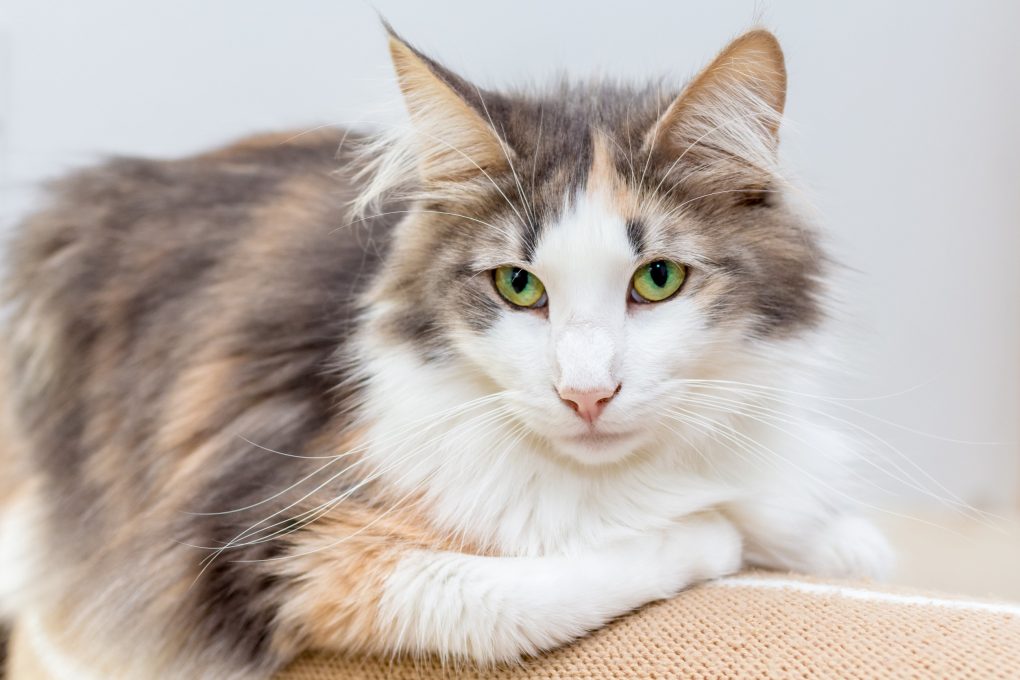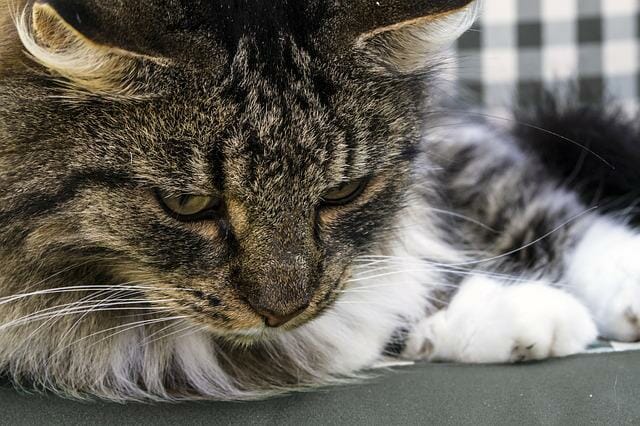Are Norwegian Forest Cats Hypoallergenic: Symptoms and Tips When Taking Care of Non-Hypoallergenic Cat
No, Norwegian Forest Cats are not considered hypoallergenic, as they produce the Fel d 1 protein found in their saliva, skin, and urine, which is the primary allergen that causes allergic reactions in humans. This protein is present in all cats, regardless of breed or hair length. Even shaving your Norwegian Forest cat will not make them hypoallergenic. At the same time, some people with allergies may be able to tolerate Norwegian Forest Cats better than other breeds.


Table of Contents
Symptoms of Cat Allergies
Sneezing
According to the American College of Allergy, Asthma, and Immunology, sneezing is a common symptom of allergies, including cat allergies. When a person with cat allergies comes into contact with cat allergens, such as dander or saliva proteins, their immune system may overreact and trigger an allergic response. This can cause the release of histamine and other chemicals, irritating the nasal lining and leading to sneezing.
Sneezing is a natural reflex that helps to expel irritants and allergens from the nasal passages. It is often accompanied by other symptoms such as a runny or stuffy nose, itching, and watery eyes.
Runny or Stuffy Nose
A runny or stuffy nose is another common symptom of cat allergies. When a person with cat allergies comes into contact with cat allergens, such as dander or saliva proteins, their immune system may overreact and trigger an allergic response. This can cause inflammation and swelling of the nasal passages, leading to a runny or stuffy nose.
A runny nose is characterized by excessive mucus discharge from the nasal passages. On the other hand, a stuffy nose is characterized by a feeling of congestion or blockage in the nasal passages, making it difficult to breathe through the nose.
Other runny or stuffy nose symptoms include sneezing, itching, and watery eyes. These symptoms can be mild or severe and interfere with daily activities and quality of life.
Itchy or Watery Eyes
Itchy or watery eyes are common symptoms of cat allergies. When a person with cat allergies comes into contact with cat allergens, such as dander or saliva proteins, their immune system may overreact and trigger an allergic response. This can cause inflammation and irritation of the eyes, leading to itching and watering.
Itching of the eyes may be accompanied by redness and swelling of the conjunctiva, which is the clear membrane covering the eye’s white part. Watery eyes occur when the eyes produce excess tears in response to the irritation and inflammation caused by the allergic reaction.
Skin Rash or Hives
Skin rash or hives are less common symptoms of cat allergies, but they can occur in some people. When a person with cat allergies comes into contact with cat allergens, such as dander or saliva proteins, their immune system may overreact and trigger an allergic response. This can cause the release of histamine and other chemicals, leading to inflammation and skin irritation, resulting in a rash or hives.
A rash is characterized by a change in the skin’s color, texture, or appearance, while hives are raised, itchy, and often appear in clusters. These symptoms can occur on any part of the body that comes into contacts with the allergen, such as the face, arms, or chest.
Difficulty Breathing or Wheezing
Difficulty breathing or wheezing are less common but serious symptoms of cat allergies. When a person with cat allergies comes into contact with cat allergens, such as dander or saliva proteins, their immune system may overreact and trigger an allergic response. This can cause inflammation and narrowing of the airways, making it difficult to breathe.
Wheezing is a high-pitched whistling sound that occurs when air flows through narrowed airways. It is often an asthma symptom triggered by cat allergies in some people. Other asthma symptoms may include coughing, chest tightness, and shortness of breath.
Tips to Reduce Cat Allergens


Use a HEPA Air Purifier
Using a HEPA air purifier can help reduce the number of allergens produced by Norwegian Forest Cats in the air. HEPA (High-Efficiency Particulate Air) filters are designed to capture small particles, including pet dander, hair, and other airborne allergens, which can help improve indoor air quality and reduce allergy symptoms.
When choosing an air purifier, look for one specifically designed for pet owners with a HEPA filter. Some air purifiers also include additional features, such as activated carbon filters that can help remove odors associated with pets.
Keep Your Home Clean
Keeping your home clean is an important strategy to help manage allergies to Norwegian Forest Cats. Regular vacuuming can help remove cat hair, dander, and other allergens from carpets and upholstery. Use a vacuum with a HEPA filter to capture small particles and reduce the number of allergens in your home.
Use a damp cloth to dust and wipe down surfaces in your home, including shelves, windowsills, and furniture. This can help remove cat hair and dander that may have settled on these surfaces. Choose cleaning products that are hypoallergenic and fragrance-free. These products are less likely to trigger allergic reactions and can help keep your home clean without introducing additional allergens.
Wash your bedding regularly, including your sheets, pillowcases, and blankets, to help remove any cat hair or dander that may have accumulated on them. Good ventilation can help reduce the number of allergens in your home. Open windows and use exhaust fans to improve air circulation and remove stale air.
Use Allergen-Blocking Bedding
Using allergen-blocking bedding can be an effective way to manage allergies to Norwegian Forest Cats. Allergen-blocking bedding is designed to create a barrier between you and any cat hair, dander, or other allergens on your bedding.
Look for bedding designed to block allergens, such as pillowcases and mattress covers labeled “allergen-proof” or “allergy-friendly.” These products are typically made from tightly woven materials to prevent allergens from passing through.
Bathe Your Cat Regularly
Regularly bathing your Norwegian Forest Cat can effectively manage allergies, as it can help remove dander and other allergens from their fur. Here are some tips for bathing your cat:
- Use a cat-friendly shampoo: Choose a shampoo that is specifically formulated for cats, as human shampoos can be too harsh and may irritate your cat’s skin. Look for a shampoo that is hypoallergenic and fragrance-free.
- Use lukewarm water: Fill a sink or bathtub with lukewarm water, and use a handheld showerhead or a cup to wet your cat’s fur. Be sure to avoid getting water in your cat’s ears.
- Apply shampoo and lather: Apply a small amount to your cat’s fur and massage it to create a lather. Be gentle and avoid scrubbing too hard.
- Rinse thoroughly: Use the showerhead or a cup to rinse your cat’s fur thoroughly, removing all the shampoos.
- Dry your cat: Use a towel to gently dry your cat’s fur or a hair dryer in a low heat setting. Be sure to avoid using a high heat setting, which can be too hot and may damage your cat’s skin.
Limit Contact With Your Cat


Limiting your contact with your Norwegian Forest Cat can be an effective way to manage allergies. Designate certain areas of your home as “cat-free” zones, such as your bedroom or home office. This can help reduce your exposure to cat allergens in areas where you spend a lot of time.
Washing your hands frequently can help remove any cat allergens that may have accumulated on your skin. Be sure to wash your hands thoroughly with soap and water for at least 20 seconds. A mask can help filter out cat allergens when you’re close to your cat. Be sure to choose a mask that is comfortable and fits well.
Limiting your contact with your cat, especially snuggling and petting, can help reduce your exposure to cat allergens. Wash your hands immediately if you want to snuggle or pet your cat.
Talk to Your Doctor
If you have allergies to cats and are considering getting a Norwegian Forest Cat, or if you already have a Norwegian Forest Cat and are experiencing allergy symptoms, it’s important to talk to your doctor. Your doctor can help confirm whether your symptoms are caused by cat allergies or something else.
Your doctor can recommend different treatment options, such as allergy medications or shots, to help manage your symptoms. In addition, your doctor can provide advice on lifestyle changes you can make to help manage your allergies, such as using air purifiers or limiting your exposure to cat allergens.
